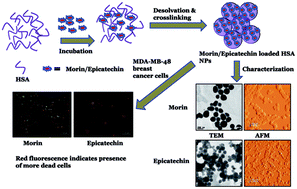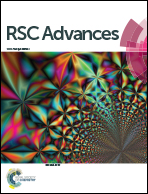Solubility enhancement of morin and epicatechin through encapsulation in an albumin based nanoparticulate system and their anticancer activity against the MDA-MB-468 breast cancer cell line
Abstract
The polyphenols morin and epicatechin exhibit properties that include antioxidant, anticancer, and anti-inflammatory activities, etc. However, their clinical application is hampered by their poor aqueous solubility and bioavailability. In the present study an attempt has been made to overcome these drawbacks by encapsulating morin and epicatechin separately into a suitable nanocarrier. We have prepared morin loaded human serum albumin (HSA) nanoparticles (Mor-HSA-NPs) and epicatechin loaded HSA nanoparticles (EC-HSA-NPs) using a desolvation technique, which have been further characterised for particle size, morphology, morin/epicatechin content in nanoparticles, and their in vitro release. The particle size of the prepared formulation was ∼170 ± 6 nm for Mor-HSA-NPs and ∼200 ± 12 nm for EC-HSA-NPs with an almost spherical shape and smooth surface. The release profile exhibited an initial burst release followed by a sustained release. The cytotoxicity of Mor-HSA-NPs and EC-HSA-NPs against the MDA-MB-468 breast cancer cell line has been investigated by MTT assay and the results show that the nanoparticles are capable of destroying the cancer cells more potently than morin/epicatechin alone. This is also supported by fluorescence microscopy images. This result is likely to facilitate an understanding of how to enhance the delivery of flavonoids like morin and epicatechin by encapsulation.


 Please wait while we load your content...
Please wait while we load your content...